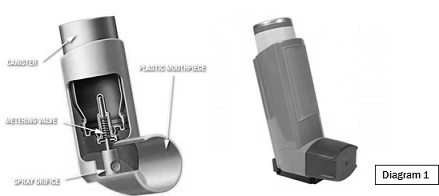Reference no: EM131431610
Design of an Asthma Reliever/Preventer Inhaler for children and teenage asthma sufferers
Project Proposal:
What is Asthma??
Asthma is a long-term condition that affects your airways - the tubes that carry air in and out of your lungs. You could say that someone with asthma has 'sensitive' airways that are inflamed and ready to react when they come into contact with something they don't like.
Asthma tends to run in families, especially when there's also a history of allergies and/or smoking.
How does asthma affect the airways?
When a person with asthma comes into contact with something that irritates their sensitive airways even more (an asthma trigger), it causes their body to react in three ways:
1. the muscles around the walls of the airways tighten so that the airways become narrower
2. the lining of the airways becomes inflamed and starts to swell
3. sticky mucus or phlegm sometimes builds up, which can narrow the airways even more.
These reactions cause the airways to become narrower and irritated - making it difficult to breathe and leading to asthma symptoms, such as chest tightness, wheezing, or coughing.
Who gets asthma?
In the UK at the moment there are currently 5.4 million sufferers of asthma,that's one in every 11 people and 1 in 5 households. Asthma affects more boys than girls. Asthma in adults is more common in women than
men. Asthma can sometimes be defined as a type, such as 'occupational' or 'severe'. According the the latest statistics, 1216 people died of Asthma in the uk in 2014.
That's 5.4 million people who live daily with the paralysing fear that they could have an attack that could potentially kill them. According to Asthma UK, "3 people in the Uk die every day of Asthma". Among Asthma sufferers there are approximately 1.1 million children and in Scotland the statistics are as follows:
368,000 people (1 in 14) are currently receiving treatment for asthma. This includes 72,000 children and 296,000 adults.
One in 11 children has asthma and it is the most common long-term medical condition. On average there are three children with asthma in every classroom in the UK.
The UK has among the highest prevalence rates of asthma symptoms in children worldwide.
Asthma attacks hospitalise someone every 8 minutes; 185 people are admitted to hospital because of asthma attacks every day in the UK (a child is admitted to hospital every 20 minutes because of an asthma attack).
Design Problem:
The task that you are being asked to carry out, is to design a new asthma inhaler that can be supplied to one of two demographics:
Primary School children age 5-10.
Secondary School Children age 10 - 16.
The users must be able to carry this inhaler on them at all times so the design could also incorporate attachment/carry solutions
The current Asthma reliever/preventer inhaler is shown in diagram 1 below:

Although there are no functional problems with this design, it is not very aesthetically pleasing and it also has some minor user issues that require to be addressed and suggestions that may help with your design decisions:
- Some users complain that the rigid design can lead to dirt or entering the mouthpiece and being ingested along with the medicine
- Some users would like the mouthpiece to be adjustable (Maybe you can recess the mouthpiece till required, keeping it clean)
- Users would like to have more modern and vibrant designs. Maybe product lines that relate to television or movie franchises, football clubs etc.
- The materials of the mouthpiece could also be changed, for the teenage demographic, maybe making it from brushed aluminium or combinations of materials to create a more attractive product.
- Can the current delivery system be completely re-designed?
Design Requirements:
Using SolidWorks, design and document your new Reliever/Preventer Inhaler design. This is mainly a design project, so don't be overly concerned about the validity of your design, (i.e) the cost of materials or the manufacturing processes involved.
The design should still be able to host the supplied canister model and theoretically deliver the required dosage, unless you have completely redesigned the delivery system.
In the powerpoint presentation you saw various examples of inhalers where the designer had thought "outside of the box" and had completely re-invisioned how an inhaler should look and perform.
Supplied Parts/Models & Additional information:
The client will supply you with a canister model of the propellant. If you wish or if your design requires, you can create your own propellant delivery system. The model for this standard canister is found on the moodle for this course.
The client has provided you with a video course in which you are shown some of the SolidWorks workflow and modelling steps required to make a standard NHS inhaler similar to the one shown in diagram 1.
You do not need to complete or submit this video course its is just supplied as a guide.
Deliverables:
An E-drawing of the finished assembly. Each design must have student matriculation number etched upon it A zip file containing all of your part and assembly files (see video on Moodle)
A report for Dr Tassieri outlining the working principles of a Metered Dose Inhaler design and an A3 formatted display board of your final design. See Link below for further information about Display board design.